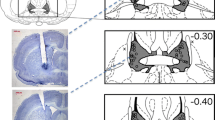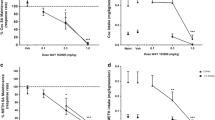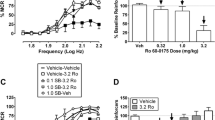Abstract
Rationale
Contradictory evidence exists regarding the role of the 5-HT2A receptor (5-HT2AR) in hyperactivity and hyperthermia elicited by the substituted amphetamine (+)-3,4-methylenedioxymethamphetamine.
Objectives
The present studies examined the ability of the selective 5-HT2AR antagonist M100907 to block hyperactivity and hyperthermia produced across the (+)-MDMA dose-effect curve.
Methods
Male rats were pretreated with M100907 (0, 0.25, 0.5, 1, and 2 mg/kg) followed by treatment with (+)-MDMA (0–12 mg/kg); activity was recorded for 90 min followed by determination of rectal temperature. Additionally, we investigated the ability of M100907 (0 and 0.5 mg/kg) to reverse hyperthermia elicited by (+)-MDMA (12 mg/kg).
Results
The first study demonstrated that M100907 attenuated hyperactivity in the periphery of the monitor and eliminated rearing induced by (+)-MDMA (3 mg/kg) with no effect on basal activity. In two subsequent studies, (+)-MDMA (0–12 mg/kg) dose-dependently increased peripheral activity and rearing and produced hyperthermia. Pretreatment with M100907 decreased peripheral activity evoked by (+)-MDMA, right-shifted the dose-effect curve for rearing, and blocked (+)-MDMA-induced hyperthermia, while having no effect when administered alone. A final study demonstrated the ability of M100907 (0.5 mg/kg) to reverse hyperthermia produced by (+)-MDMA (12 mg/kg).
Conclusions
These results suggest that the 5-HT2AR contributes to the generation of peripheral hyperactivity and rearing and, especially, the hyperthermia evoked by (+)-MDMA and that 5-HT2AR antagonists should be further investigated as treatments for the psychological and hyperthermic effects of (±)-MDMA.




Similar content being viewed by others
References
Bankson MG, Cunningham KA (2002) Pharmacological studies of the acute effects of (+)-3,4-methylenedioxymethamphetamine on locomotor activity: role of 5-HT1B/1D and 5-HT2 receptors. Neuropsychopharmacology 26:40–52
Barr AM, Lehmann-Masten VL, Paulus M, Gainetdinov RR, Caron MG, Geyer MA (2004) The selective serotonin-2A receptor antagonist M100907 reverses behavioral deficits in dopamine transporter knockout mice. Neuropsychopharmacology 29:221–228
Battaglia G, Brooks BP, Kulsakdinun C, de Souza EB (1988) Pharmacologic profile of MDMA (3,4-methylenedioxymethamphetamine) at various brain recognition sites. Eur J Pharmacol 149:159–163
Blessing WW, Seaman B, Pedersen NP, Ootsuka Y (2003) Clozapine reverses hyperthermia and sympathetically mediated cutaneous vasoconstriction induced by 3,4-methylenedioxymethamphetamine (ecstasy) in rabbits and rats. J Neurosci 23:6385–6391
Bonaccorso S, Meltzer HY, Li Z, Dai J, Alboszta AR, Ichikawa J (2002) SR46349-B, a 5-HT(2A/2C) receptor antagonist, potentiates haloperidol-induced dopamine release in rat medial prefrontal cortex and nucleus accumbens. Neuropsychopharmacology 27:430–441
Bubar MJ, Pack KM, Frankel PS, Cunningham KA (2004) Effects of dopamine D1- or D2-like receptor antagonists on the hypermotive and discriminative stimulus effects of (+)-MDMA. Psychopharmacology 173:326–336
Cami J, Farre M, Mas M, Roset PN, Poudevida S, Mas A, San L, de la Torre R (2000) Human pharmacology of 3,4-methylenedioxymethamphetamine (“ecstasy”): psychomotor performance and subjective effects. J Clin Psychopharmacol 20:455–466
Dafters RI (1994) Effect of ambient temperature on hyperthermia and hyperkinesis induced by 3,4-methylenedioxymethamphetamine (MDMA or “ecstasy”) in rats. Psychopharmacology 114:505–508
Dar KJ, McBrien ME (1996) MDMA induced hyperthermia: report of a fatality and review of current therapy. Intensive Care Med 22:995–996
Davison D, Parrott AC (1997) Ecstasy (MDMA) in recreational users: self-reported psychological and physiological effects. Hum Psychopharmacol 12:221–226
Delfs JM, Schreiber L, Kelley AE (1990) Microinjection of cocaine into the nucleus accumbens elicits locomotor activation in the rat. J Neurosci 10:303–310
Doherty MD, Pickel VM (2000) Ultrastructural localization of the serotonin 2A receptor in dopaminergic neurons in the ventral tegmental area. Brain Res 864:176–185
Fantegrossi WE, Godlewski T, Karabenick RL, Stephens JM, Ullrich T, Rice KC, Woods JH (2003) Pharmacological characterization of the effects of 3,4-methylenedioxymethamphetamine (“ecstasy”) and its enantiomers on lethality, core temperature, and locomotor activity in singly housed and crowded mice. Psychopharmacology 166:202–211
Fletcher PJ, Korth KM, Robinson SR, Baker GB (2002) Multiple 5-HT receptors are involved in the effects of acute MDMA treatment: studies on locomotor activity and responding for conditioned reinforcement. Psychopharmacology 162:282–291
Gold LH, Hubner CB, Koob GF (1989) A role for the mesolimbic dopamine system in the psychostimulant actions of MDMA. Psychopharmacology 99:40–47
Herin DV, Cunningham KA (2001) Potentiation of (+)-3,4-methylenedioxymethamphetamine [(+)-MDMA]-induced hyperactivity by the selective 5-HT2C receptor antagonist SB 242084. Soc Neurosci 26:221.18 (Abstr)
Hillegaart V, Estival A, Ahlenius S (1996) Evidence for specific involvement of 5-HT1A and 5-HT2A/C receptors in the expression of patterns of spontaneous motor activity of the rat. Eur J Pharmacol 295:155–161
Hitchcock JM, Lister S, Fischer TR, Wettstein JG (1997) Disruption of latent inhibition in the rat by the 5-HT2 agonist DOI: effects of MDL 100,907, clozapine, risperidone, and haloperidol. Behav Brain Res 88:43–49
Kankaanpaa A, Meririnne E, Lillsunde P, Seppala T (1998) The acute effects of amphetamine derivatives on extracellular serotonin and dopamine levels in rat nucleus accumbens. Pharmacol Biochem Behav 59:1003–1009
Kehne JH, Baron BM, Carr AA, Chaney SF, Elands J, Feldman DJ, Frank RA, van Giersbergen PL, McCloskey TC, Johnson MP, McCarty DR, Poirot M, Senyah Y, Siegel BW, Widmaier C (1996a) Preclinical characterization of the potential of the putative atypical antipsychotic MDL 100,907 as a potent 5-HT2A antagonist with a favorable CNS safety profile. J Pharmacol Exp Ther 277:968–981
Kehne JH, Ketteler HJ, McCloskey TC, Sullivan CK, Dudley MW, Schmidt CJ (1996b) Effects of the selective 5-HT2A receptor antagonist MDL 100,907 on MDMA-induced locomotor stimulation in rats. Neuropsychopharmacology 15:116–124
Keppel G (1991) Design and analysis, a researcher’s handbook. Prentice Hall, New Jersey
Liechti ME, Saur MR, Gamma A, Hell D, Vollenweider FX (2000) Psychological and physiological effects of MDMA (“ecstasy”) after pretreatment with the 5-HT2 antagonist ketanserin in healthy humans. Neuropsychopharmacology 23:396–404
Malberg JE, Seiden LS (1998) Small changes in ambient temperature cause large changes in 3,4-methylenedioxymethamphetamine (MDMA)-induced serotonin neurotoxicity and core body temperature in the rat. J Neurosci 18:5086–5094
McCreary AC, Bankson MG, Cunningham KA (1999) Pharmacological studies of the acute and chronic effects of (+)-3,4-methylenedioxymethamphetamine on locomotor activity: role of 5-hydroxytryptamine 1A and 5-hydroxytryptamine 1B/1D receptors. J Pharmacol Exp Ther 290:965–973
McCreary AC, Filip M, Cunningham KA (2003) Discriminative stimulus properties of (±)-fenfluramine: the role of 5-HT2 receptor subtypes. Behav Neurosci 117:212–221
Mechan AO, Esteban B, O’Shea E, Elliott JM, Colado MI, Green AR (2002) The pharmacology of the acute hyperthermic response that follows administration of 3,4-methylenedioxymethamphetamine (MDMA, “ecstasy”) to rats. Br J Pharmacol 135:170–180
Mlinar B, Corradetti R (2003) Endogenous 5-HT, released by MDMA through serotonin transporter- and secretory vesicle-dependent mechanisms, reduces hippocampal excitatory synaptic transmission by preferential activation of 5-HT1B receptors located on CA1 pyramidal neurons. Eur J Neurosci 18:1559–1571
Morgan MJ (2000) Ecstasy (MDMA): a review of its possible persistent psychological effects. Psychopharmacology 152:230–248
Nash JF, Roth BL, Brodkin JD, Nichols DE, Gudelsky GA (1994) Effect of the R(−) and S(+) isomers of MDA and MDMA on phosphatidyl inositol turnover in cultured cells expressing 5-HT2A or 5-HT2C receptors. Neurosci Lett 177:111–115
Nisijima K, Yoshino T, Yui K, Katoh S (2001) Potent serotonin 5-HT2A receptor antagonists completely prevent the development of hyperthermia in an animal model of the 5-HT syndrome. Brain Res 890:23–31
Ouagazzal A, Grottick AJ, Moreau J, Higgins GA (2001) Effect of LSD on prepulse inhibition and spontaneous behavior in the rat. A pharmacological analysis and comparison between two rat strains. Neuropsychopharmacology 25:565–575
Patel S, Fernandez-Garcia E, Hutson PH, Patel S (2001) An in vivo binding assay to determine central α1-adrenoceptor occupancy using [3H]prazosin. Brain Res Brain Res Protoc 8:191–198
Paulus MP, Geyer MA (1992) The effects of MDMA and other methylenedioxy-substituted phenylalkylamines on the structure of rat locomotor activity. Neuropsychopharmacology 7:15–31
Peroutka SJ (1986) Pharmacological differentiation and characterization of 5-HT1A, 5-HT1B, and 5-HT1C binding sites in rat frontal cortex. J Neurochem 47:529–540
Pessia M, Jiang ZG, North RA, Johnson SW (1994) Actions of 5-hydroxytryptamine on ventral tegmental area neurons of the rat in vitro. Brain Res 654:324–330
Roth BL, Kroeze WK, Patel S, Lopez E (2000) The multiplicity of serotonin receptors: uselessly diverse molecules or an embarrasment of riches? Neuroscientist 6:252–262
Rothman RB, Baumann MH, Savage JE, Rauser L, McBride A, Hufeusen SJ, Roth BL (2000) Evidence for possible involvement of 5-HT2B receptors in the cardiac valvulopathy associated with fenfluramine and other serotonergic medications. Circulation 102:2836–2841
Rothman RB, Baumann MH, Dersch CM, Romero DV, Rice KC, Carroll FI, Partilla JS (2001) Amphetamine-type central nervous system stimulants release norepinephrine more potently than they release dopamine and serotonin. Synapse 39:32–41
Rudnick G, Wall SC (1992) The molecular mechanism of “ecstasy” [3,4-methylenedioxy-methamphetamine (MDMA)]: serotonin transporters are targets for MDMA-induced serotonin release. Proc Natl Acad Sci USA 89:1817–1821
Schmidt CJ, Fadayel GM, Sullivan CK, Taylor VL (1992) 5-HT2 receptors exert a state-dependent regulation of dopaminergic function: studies with MDL 100,907 and the amphetamine analogue, 3,4-methylenedioxymethamphetamine. Eur J Pharmacol 223:65–74
Sheskin DJ (2000) Handbook of parametric and nonparametric statistical procedures. Chapman and Hall/CRC, New York/Boca Raton
Spanos LJ, Yamamoto BK (1989) Acute and subchronic effects of methylenedioxymethamphetamine [(±)MDMA] on locomotion and serotonin syndrome behavior in the rat. Pharmacol Biochem Behav 32:835–840
Van Oekelen D, Megens A, Meert T, Luyten WH, Leysen JE (2002) Role of 5-HT2 receptors in the tryptamine-induced 5-HT syndrome in rats. Behav Pharmacol 13:313–318
Wettstein JG, Host M, Hitchcock JM (1999) Selectivity of action of typical and atypical anti-psychotic drugs as antagonists of the behavioral effects of 1-[2,5-dimethoxy-4-iodophenyl]-2-aminopropane (DOI). Prog Neuropsychopharmacol Biol Psychiatry 23:533–544
Acknowledgements
This research was supported by National Institute on Drug Abuse grants DA 00260, DA 13595, DA 07287, and DA 15272. Portions of these data were presented at the 64th annual meeting of the College on Problems of Drug Dependence (Quebec City, Canada, 2002) and the biannual meeting of the European Behavioral Pharmacology Society (Antwerp, Belgium, 2003). We gratefully thank Teri Tarrant for secretarial assistance and Marcy J. Bubar, Jeff J. Burmeister, Julie D. Ross, and Regina P. Szucs for their comments and suggestions. We would also like to thank the National Institute on Drug Abuse for providing us with (+)-MDMA.
Author information
Authors and Affiliations
Corresponding author
Rights and permissions
About this article
Cite this article
Herin, D.V., Liu, S., Ullrich, T. et al. Role of the serotonin 5-HT2A receptor in the hyperlocomotive and hyperthermic effects of (+)-3,4-methylenedioxymethamphetamine. Psychopharmacology 178, 505–513 (2005). https://doi.org/10.1007/s00213-004-2030-4
Received:
Accepted:
Published:
Issue Date:
DOI: https://doi.org/10.1007/s00213-004-2030-4




